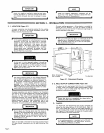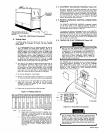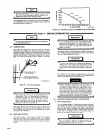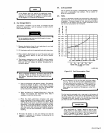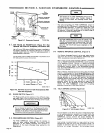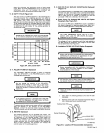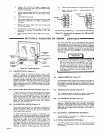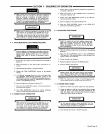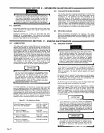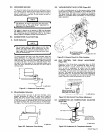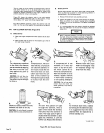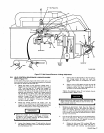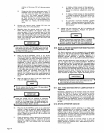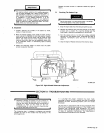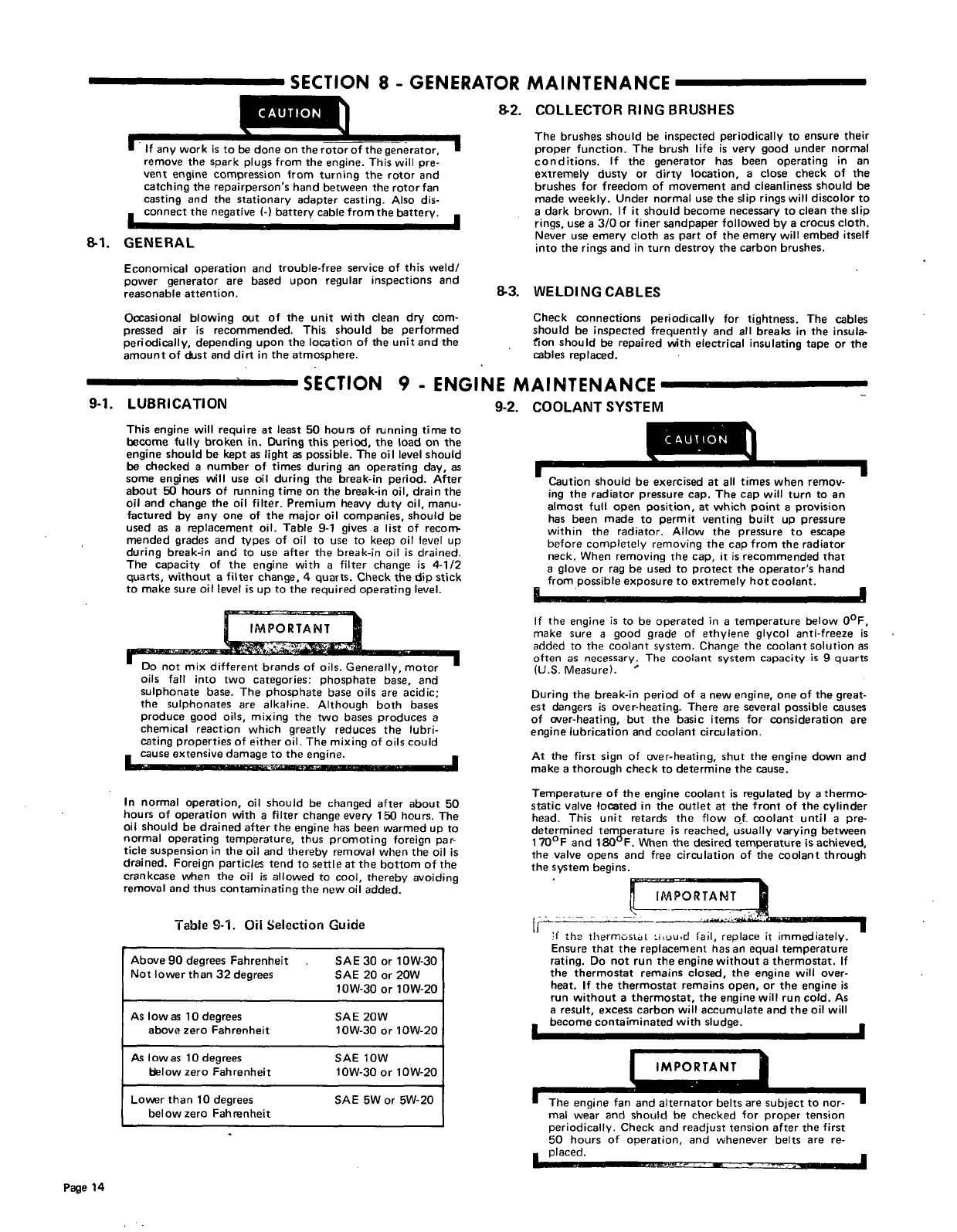
SECTION
8
-
GENERATOR
MAINTENANCE
CAUTION__.!
1
If
any
work
is
to
be
done
on
the
rotor
o~enerator,
remove
the
spark
plugs
from
the
engine.
This
will
pre
vent
engine
compression
from
turning
the
rotor
and
catching
the
repairpersons
hand
between
the
rotor
fan
casting
and
the
stationary
adapter
casting.
Also
dis
connect
the
negative
I-)
battery
cable
from
the
battery.
8-1.
GENERAL
Economical
operation
and
trouble-free
service
of
this
weld/
power
generator
are
based
upon
regular
inspections
and
reasonable
attention.
Ottasional
blowing
out
of
the
unit
with
clean
dry
com
pressed
air
is
recommended.
This
should
be
performed
periodically,
depending
upon
the
location
of
the
unit
and
the
amount
of
ckist
and
dirt
in
the
atmosphere.
8-2.
COLLECTOR
RING
BRUSHES
The
brushes
should
be
inspected
periodically
to
ensure
their
proper
function.
The
brush
life
is
very
good
under
normal
conditions.
If
the
generator
has
been
operating
in
an
extremely
dusty
or
dirty
location,
a
close
check
of
the
brushes
for
freedom
of
movement
and
cleanliness
should
be
made
weekly.
Under
normal
use
the
slip
rings
will
discolor
to
a
dark
brown.
If
it
should
become
necessary
to
clean
the
slip
rings,
use
a
3/0
or
finer
sandpaper
followed
by
a
crocus
cloth.
Never
use
emery
cloth
as
part
of
the
emery
will
embed
itself
into
the
rings
and
in
turn
destroy
the
carbon
brushes.
8-3.
WELDING
CABLES
Check
connections
periodically
for
tightness.
The
cables
should
be
inspected
frequently
and
all
brealc
in
the
insula
flon
should
be
repaired
with
electrical
insulating
tape
or
the
cables
replaced.
SECTION
9
-
ENGINE
MAINTENANCE
9-1.
LUBRICATION
This
engine
will
require
at
least
50
hours
of
running
time
to
become
fully
broken
in.
During
this
period,
the
load
on
the
engine
should
be
kept
as
light
as
possible.
The
oil
level
should
be
checked
a
number
of
times
during
an
operating
day,
as
some
engines
will
use
oil
during
the
break-in
period.
After
about
50
hours
of
running
time
on
the
break-in
oil,
drain
the
oil
and
change
the
oil
filter.
Premium
heavy
duty
oil,
manu
factured
by
any
one
of
the
major
oil
companies,
should
be
used
as
a
replacement
oil.
Table
9-1
gives
a
list
of
recom
mended
grades
and
types
of
oil
to
use
to
keep
oil
level
up
during
break-in
and
to
use
after
the
break-in
oil
is
drained.
The
capacity
of
the
engine
with
a
filter
change
is
4-1/2
quarts,
without
a
filter
change.
4
quarts.
Check
the
dip
stick
to
make
sure
oil
level
is
up
to
the
required
operating
level.
9-2.
COOLANT
SYSTEM
Caution
should
be
exercised
at
all
times
when
remov
ing
the
radiator
pressure
cap.
The
cap
will
turn
to
an
almost
full
open
position,
at
which
point
a
provision
has
been
made
to
permit
venting
built
up
pressure
within
the
radiator.
Allow
the
pressure
to
escape
before
completely
removing
the
cap
from
the
radiator
neck.
When
removing
the
cap,
it
is
recommended
that
a
glove
or
rag
be
used
to
protect
the
operators
hand
from
possible
exposure
to
extremely
hot
coolant.
~mixd4erenandso!ls.GeneraIly,motor
oils
fall
into
two
categories:
phosphate
base,
and
sulphonate
base.
The
phosphate
base
oils
are
acidic;
the
sulphonates
are
alkaline.
Although
both
bases
produce
good
oils,
mixing
the
two
bases
produces
a
chemical
reaction
which
greatly
reduces
the
lubri
cating
properties
of
either
oil.
The
mixing
of
oils
could
~cause
extensive
damage
to
the
engine.
1
If
the
engine
is
to
be
operated
in
a
temperature
below
0F,
make
sure
a
good
grade
of
ethylene
glycol
anti-freeze
is
added
to
the
coolant
system.
Change
the
coolant
solution
as
often
as
necessary.
The
coolant
system
capacity
is
9
quarts
lU.S.
Measure).
During
the
break-in
period
of
a
new
engine,
one
of
the
great
est
dangers
is
over-heating.
There
are
several
possible
causes
of
over-heating,
but
the
basic
items
for
consideration
are
engine
lubrication
and
coolant
circulation.
At
the
first
sign
of
over-heating,
shut
the
engine
down
and
make
a
thorough
check
to
determine
the
cause.
In
normal
operation,
oil
should
be
changed
after
about
50
hours
of
operation
with
a
filter
change
every
150
hours.
The
oil
should
be
drained
after
the
engine
has
been
warmed
up
to
normal
operating
temperature,
thus
promoting
foreign
par
ticle
suspension
in
the
oil
and
thereby
removal
when
the
oil
is
drained.
Foreign
particles
tend
to
settle
at
the
bottom
of
the
crankcase
when
the
oil
is
allowed
to
cool,
thereby
avoiding
removal
and
thus
contaminating
the
new
oil
added.
Temperature
of
the
engine
coolant
is
regulated
by
a
thermo
static
valve
located
in
the
outlet
at
the
front
of
the
cylinder
head.
This
unit
retards
the
flow
oL
coolant
until
a
pre
determined
tem~erature
is
reached,
usually
varying
between
170F
and
180
F.
When
the
desired
temperature
is
achieved,
the
valve
opens
and
free
circulation
of
the
coolant
through
the
system
begins.
1
th~
tliermostal
uiuud
fail,
replace
it
immediately.
Ensure
that
the
replacement
has
an
equal
temperature
rating.
Do
not
run
the
engine
without
a
thermostat.
If
the
thermostat
remains
closed,
the
engine
will
over
heat.
If
the
thermostat
remains
open,
or
the
engine
is
run
without
a
thermostat,
the
engine
will
run
cold.
As
a
result,
excess
carbon
will
accumulate
and
the
oil
will
become
contaiminated
with
sludge.
flTAr~
The
engine
fan
and
alternator
belts
are
subject
to
nor
mal
wear
and
should
be
checked
for
proper
tension
periodically.
Check
and
readjust
tension
after
the
first
50
hours
of
operation,
and
whenever
belts
are
re
placed.
CAUTION
N
U
I
Table
9-1.
Oil
Selection
Guide
Above
90
degrees
Fahrenheit
.
SAE3O
or
10W-30
Not
lower
than
32
degrees
SAE
20
or
20W
1OW-30
or
1OW-20
As
low
as
10
degrees
SAE
20W
above
zero
Fahrenheit
1OW-30
or
1OW-20
Aslowas
lOdegrees
SAE
lOW
slow
zero
Fahrenheit
1OW-30
or
1OW-20
Lower
than
10
degrees
SAE
SW
or
5W-20
below
zero
Fahrenheit
I
Page
14



